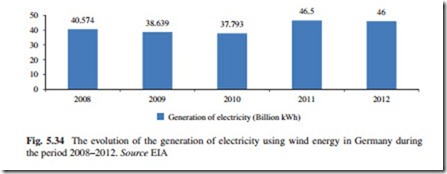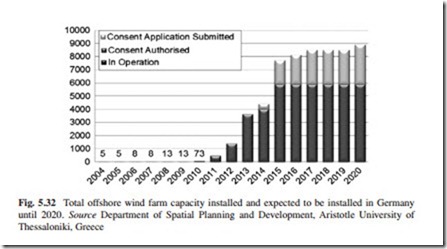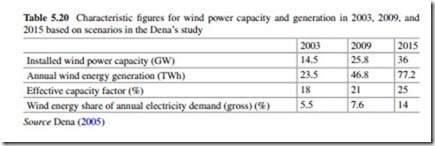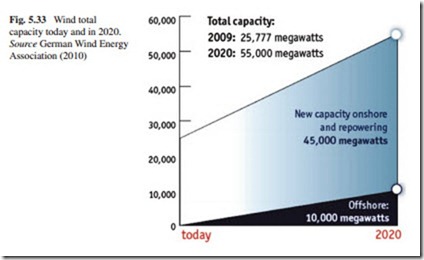Germany
Germany continues to lead Europe as the number one wind energy country with 31,308 MW of installed capacity in 2012. The evolution of the wind power- installed capacity in Germany during the period 2007–2012 is included in Table 5.19.
In 2012, the country added 2,233 MW, increasing wind power capacity installed in the country to a record level of 31,308 MW. The wind power capacity installed in the Germany represents 18.6 % of the total energy capacity installed and 41.74 % of the total renewables capacity installed in that year. The country occupies the place number 3 at world level according to the wind power capacity installed (11.01 % of world total) and the place number 1 at regional level (28.7 % of the regional total). It is important to single out that the wind power capacity installed in the country increases each year during the past ten years.
The leading German federal state in terms of wind power deployment is Lower Saxony with 6,664 MW of wind power capacity installed. A number of states now generate more than 40 % of their electricity from wind energy. The states are Saxony-Anhalt (52.14 %), Mecklenburg-Vorpommern (45.37 %), and Schleswig- Holstein (44.1 %).
According to the Germany Wind Energy Association, the country could host a little bit more than 45,000 MW of onshore and 10,000 MW of offshore wind by 2020 and could generate approximately 150 TWh per year or about 25 % of German electricity consumption.
On the other hand, the EU Renewable Energy Directive approved by the EU, assigned Germany a target of 18 % renewable energy in final energy consumption. In the electricity sector, the government’s target is 38.6 % of renewable electric- ity by 2020. Until now, it is expected that the total offshore wind farm capacity in Germany in 2020 could reach 9,000 MW (see Fig. 5.32).
According to Zervos and Kjaer (2008), Germany is an EU leader in wind utilization, solar PV, solar thermal installations, and biofuel production. Its onshore wind capacity covers approximately 50 % of the total installed capacity in the EU. A stable and predictable policy framework has created conditions favorable to renewable energy sources penetration and growth. FiT for the use of renew- able energy sources for the generation of electricity have proven to be a successful policy, leading to a very dynamic market for this type of energy.
With the aim of promoting the use of renewable energy sources for the generation of electricity, Germany has introduced the following schemes:
• FiTs for onshore and offshore wind, solar PV, biomass, hydro, landfill gas, sew- age gas, and geothermal;
• Large subsidized loans available through the Deutsche Ausgleichsbank (DtA)
Environment and Energy Efficiency Program.
The use of renewable energy sources for the generation of electricity targets set for Germany is 12.5 % of gross electricity consumption in 2010 and 20 % in 2020; this represents an increase of 7.5 % for the next ten years. All renewable energy sources combined produced today around 16 % of Germany’s electricity needs, with wind being the largest single contributor within the renewable energy mix.
In Germany, since 2000, electricity produced from renewable energy sources gives priority for connection to the grid, purchase, transmission, and payments. German grid operators are obliged to feed on electricity produced from renewable energy and buy it at a minimum price within their supply area. In order to allow for technological progress and continuous cost reduction, the compensation rates are subject to nominal annual digression.
For onshore wind farm development in Germany, the amount of sites commissioned is decreasing, while repowering is proceeding at a slow pace. Repowering could play a stronger role in Germany today, but numerous federal states have issued recommendations concerning vicinity and height restrictions, and there- fore, hindering the use of a large number of suitable sites could. Examples are Brandenburg announcing a 50 % increase of existing designated sites for new pro- jects, including repowering aiming to reach about 7,500 MW by 2020, Schleswig- Holstein declaring that wind power will be the leading energy source in the state and that 4,000 MW are to be installed by 2020 on one per cent of the state’s area and Lower Saxony where the government target is to meet 50 % of the state’s electricity needs from wind energy by 2012, increasing to over 100 % by 2021 of which 10,000 MW is to be delivered onshore.
A recent study published by the Ministry of the Environment includes a projection for offshore wind capacity between 12,000 and 15,500 MW by 2020. More than 60,000 MW of projects have been proposed by various companies and consortia. Eleven projects were licensed by the end of 2005 in the North and the Baltic Seas by the national maritime authority. The North German state of Schleswig-Holstein has 1,800 MW of installed wind capacity, enough to meet 30 % of the region’s total electricity demand.
The European Investment Bank will support Germany’s move toward more green power with the allocation of billions of euros in coming years, focusing on offshore wind and transport grids. It is important to highlight that roughly €1.1 billion of an overall €7 billion credit volume, extended to Germany in 2010, was devoted to energy, and that figure is due to rise by 2020. The EIB has already signed loan agreements for two German offshore wind parks and is planning two more. However, substantial investment was needed to build more renewable energy capacity in Germany and connect this with other European countries, due to its leading economic role, but also due to the fact that it shares borders with nine countries. In the wake of the Fukushima Daiichi nuclear disaster, the government has been even keener to shift the fuel mix away from fossil and nuclear energy than in its previous strategy.
According to Hammons and others, a special high growth is expected in the wind power sector where Germany currently has a share of approximately 28.7 % of whole European capacity. Beginning in 2007, further growth was focused primar- ily on offshore locations where large wind farms with some hundred MW installed power is being erected. Taking into account the achievable full-load hours of the dif- ferent generation technologies, the contribution of renewable energy sources in the whole energy balance of Germany will be achieved in 2020. However, their maxi- mum contribution in strong wind situations will be the following:
• A 70 % for peak load;
• A 100 % for weak load coverage, where 58 and 83 % of the shares, respectively, will come from fluctuating sources with an intermitting output depending on meteorological conditions (wind or solar).
Such a large share of fluctuating power contribution requires advanced solutions to maintain power system security.
The most prominent integration study in Germany is the Dena’s study published in 2005 and is still considered as a milestone. It looked into a scenario whereby there would be 15 % wind energy penetration expected by 2015 (34 GW) (Dena 2005). It concluded that the required reserve capacities can be met with the existing generation plant configuration and its operating method as developed in this study. Wind power plant capacity and generation figures are given in Table 5.20. The study assumed a total generating capacity in Germany of 125 GW (2003), 40 GW, of which have to be replaced before 2020 taking into account existing interconnectors at the German borders. To balance the system with unforeseen variations in wind power, short-term and hourly reserves must be pro- vided, capable of positive and negative regulation.
In 2003, an average of 1.2 GW and a maximum of 2 GW of wind-related positive regulation power had to be available one day ahead in Germany. By 2015, that amount would rise to an average of 3.2 GW and a maximum of 7 GW. The mean value corresponds to 9 % of the installed wind power capacity and the maximum of 19.4 %. These capacities have to be available as positive minute and hourly reserves. In 2003, an average of 0.75 GW and a maximum of 1.9 GW of wind- related negative regulation power had to be available one day ahead. By 2015, that amount would rise to an average of 2.8 GW and a maximum of 5.5 GW. The mean value corresponds to about 8 % of the installed wind power capacity, and the maximum of 15.3 %.
Three major problems need to be solved as the first priority in order to increase the participation of wind power in the generation of electricity in Germany. First, wind power output depends on meteorological conditions and may be intermittent. In addition to application of prediction tools for power schedule planning, a higher level of reserve power than before should be provided.
As wind power in feed increases, the transmission capacity of the network becomes a further problem. Wind farms are mostly constructed in relatively less developed regions in the North of Germany. The transmission networks in these
regions have been expanded to only a limited extent. Appropriate transmission capacities must be created in order for the power to reach the load centers.
The fault ride-through wind power plants should be adapted in such a way that wind generators contribute during short-circuit currents and during network recovery after fault clearing. In most cases, the wind velocities in Northern Germany, as well as over the Baltic and North Seas, are mostly within the range of 3–12 m/s. Within this range, the power produced by a wind generator depends greatly on the wind velocity. Wind power producers basically feed in the maximum possible power obtainable from the wind, and they receive a statutory payment.
Thus, planning the power balance of a transmission system depends substantially on the precision of weather forecasts, quite particularly if the share of wind power generation accounts for a significant portion of the network load. Special prediction tools for wind power generation have been developed and applied. However, their accuracy is limited and additional reserve power, significantly over the level, which is required for primary reserve to compensate outages in the UCTE grid (German share 750 MW), shall be provided for ensuring reliable system operation. Ongoing work toward improving the prediction accuracy is directed at minimizing the reserve power.
The solution to the second problem, grid enhancement, is restricted by legal difficulties and the long-term permission process for installation of new trans- mission lines. Moreover, existing conventional power plants will offer their generating capacity on the free market, selling it throughout Germany or Europe. Consequently, free energy trading is suffering increasing constriction owing to a lack of transmission capacity, and the installation of new transmission capacity will become mandatory. But from an economic viewpoint, it is just the time to rethink the situation and to consider whether the network ought to be expanded for about 60 strong wind days per year, or whether generation management for wind power installations ought to be approved for this relatively short time.
Thirdly, apart from local impacts, wind power also has a number of system- wide impacts because it affects power system dynamic and stability, reactive power and voltage control, and frequency control and load following/dispatch of conventional units.
The wind generators should fulfill three main aspects:
• No excitation of power oscillations after grid disturbances;
• In-feed of reactive power during and after system faults;
• Maintaining system stability, minimize grid disruption.
Wind turbines installed in the German power system before 2003 had a sin- gle response to fault situations on the grid that resulted in instantaneous voltage drops: They were tipped off to protect their function until the grid recovered. The immediate loss of generation can impact on system stability and lead to cascaded tripping of some thousand MW of wind power. Faults in some grid locations can cause power tripping that is much higher than the whole spinning (primary) reserve of the European Network of Transmission System Operators for Electricity grid of 3,000 MW. For this reason, new rules for grid connection of wind power plants were established. These rules describe the requirements regarding fault ride-through capability of wind turbines.
The NREAP indicates that Germany will meet its binding 2020 target of 18 % renewable domestically and, moreover, exceed it by 1.6 %. Renewables in the power sector play a dominant role in the action plan with 38.6 % of electricity demand expected to be met by renewable in 2020. Wind has the largest share with onshore and offshore capacity accounting for 52 % of the target, or almost 20 % of all electricity consumption.
In terms of build-out, the German NREAP expects new net annual onshore capacity to decrease steadily from over 1.6 GW in 2011 to less than 300 MW in 2020. Conversely, new offshore capacity increases steadily from under 300 MW in 2010 to over 1,700 MW in 2020. Overall, the plan forecasts 45,750 MW in 2020, 10,000 MW of which offshore (see Table 5.21 and Fig. 5.33). Consequently, the onshore ambition is lower than in EWEA’s scenario, while offshore is in line with the scenario’s higher end. The German NREAP, therefore, seems to underestimate Germany’s onshore wind development potential and the effects of repowering.
Most German offshore wind parks will be erected between 20 and 60 km from the coastline in waters 20–40 m deep. Thus far, the Federal Maritime and Hydrographic Agency and the federal states have licensed 24 projects, adding up to an overall capacity of about 7,000 MW. The costs of connecting offshore wind farms to the mainland grid are covered by transmission systems operators (TSOs). The TSOs have therefore started to plan new connection lines for clusters of pro- jects at sea which takes additional time. To date, only one connection is under con- struction; Three others have been licensed. The new offshore tariffs put in place by government seek to compensate for the higher construction and operation costs offshore as well as the higher risk expectations of investors, banks, and insurance companies, at least as far as the larger North Sea projects are concerned.14
For wind energy an “initial tariff” is fixed for at least 5 and up to 20 years, after which it is then reduced to a “basic tariff”, depending on how local wind conditions compare to a reference yield. Wind installations on very good sites (reference yield of 150 %) receive the initial tariff for only five years. For turbines on sites with lesser wind conditions this period can be extended. In total, tariffs are paid for 20 years. No compensation is granted for turbines with a reference energy yield of less than 60 % to discourage installation of wind turbines on unfavorable sites.
The amended EEG entered into force in January 2009, including an increased initial tariff for onshore wind energy of €9.2 cent per kWh up from €8.7 cent per kWh. The basic tariff was set at €5.02 cent per kWh. There is an annual digression of 1 % for new installations. Hence, since 1 January 2010, the initial tariff for onshore wind was €9.02 cent per kWh.
The tariff for offshore wind energy was increased to €13 cent per kWh, plus an additional “sprinter bonus” of €2 cent per kWh for projects which start operation before the end of 2015. The initial €15 cent per kWh will be paid for a period of 12 years, and then decreased to €3.5 cent per kWh. There is an additional prolongation if the offshore site is located in deep waters and at a large distance from the coast. Offshore tariffs will annually decrease by 5 % for new installations starting in 2015. A bonus for improved grid compatibility of €0.5 cent per kWh was also introduced, and the special tariff (repowering bonus) was kept for replacing turbines that are ten years or older with new turbines, if the project doubles in rated capacity. In 2010, 56 MW were repowered to reach 183 MW. Last amendment of the act was carried out in 2014.
Contrary to the German onshore wind market, the offshore market is dominated by bigger players, with large energy utilities acting as the main investors. In 2009, a new spatial structure for the North and Baltic Sea was implemented. It includes preferential zones for wind energy development, zones where wind development is possible, and exclusion zones for wind development in existing Natura 2000 areas.
Repowering can and will play a stronger role in Germany in the future. Studies and first projects in coastal areas estimate that repairing has the potential to double the amount of onshore wind capacity in Germany with significantly fewer turbines and to triple the energy yield. Despite the high technical potential, repowering in Germany is proceeding at a slow pace because most turbines are not old enough. In most cases, repowering is only economical after 15 and more years of operation. In 2009, repowering accounted for 136 MW of new installed capacity. Nevertheless, after 2010, repowering should increase significantly. By the end of 2015, more than 6,000 MW will be older than 15 years.
In many regions, height restrictions inhibit the production of turbines yielding the maximum amount of energy. In 2010, the government and some states (for example, North Rhine-Westphalia and Schleswig-Holstein) have started rethinking their framework conditions to allow for continuous onshore development and have entered into discussions with local and regional planning authorities at a broader level.
Another key challenge for expanding renewable energy in Germany is speedy grid expansion, which includes underground cabling in critical areas. In the meantime, it will be important to improve the overall grid transport capacity in the country through soft measures such as temperature monitoring of overhead lines, high-temperature conductors, load flow management, and other smart grid options.
Finally, it is important to highlight the following: Germany is planning an energy superhighway from North to South to connect its growing wind energy supply with high-energy demand regions. Both onshore and offshore, wind energy is so far generated primarily in Northern Germany, whereas energy consumption is highest in Southern and Western regions. Offshore wind power, in particular, is a high-growth focus of the country, and for this reason, the government is ready to approve new offshore wind farms in order to help that growth along. With the goal of 25 GW of electricity from offshore wind installations by 2030, wind energy could replace 20 nuclear power plants, reducing to zero the participation of this type of energy for the production of electricity in the next decade.
This year, Germany’s KfW Banking Group is expected to initiate a special program for offshore wind, making €5 billion credit available for the construction of Germany’s first ten offshore wind farms. Germany’s first Baltic Sea wind farm went already online. The 48.3-MW wind farm—Baltic 1—will create enough electricity for up to 50,000 homes. Baltic 1 went online on May 2011 and will generate up to 185 GW hours of electricity annually. It joins North Sea wind farm alpha-ventus (60 MW), which began operating in 2010.
Germany’s ambitious energy plans call for the extensive expansion of wind energy, especially the offshore segment. Plans to revolutionize the country’s energy grid and provide attractive loans for offshore parks clear the way for fur- ther investments in the sector. For manufacturers, suppliers, and researchers, it is an excellent time to invest in Germany, states Anne Brautigam, wind energy expert at Germany Trade and Invest in Berlin.
Currently, Bard offshore 1, with a capacity of 400 MW, is under construction in the North Sea and large-scale wind farms are in development in both seas, with supply and service contracts currently being awarded. These include Baltic 2, Dan Tysk (each with a capacity of 288 MW), Nordsee Ost (with a capacity of 295 MW), and Amrumbank West (with a capacity of 300 MW).
A wind energy superhighway will help make good use of this wind farm and the many more that are planned, efficiently bringing the electricity produced to the locations that need it most.
Generation of Electricity Using Wind Energy
The evolution of the generation of electricity using wind energy in Germany during the period 2008–2012 is shown in Fig. 5.34.
According to Fig. 5.34, the following can be stated: The generation of electricity in Germany using wind energy during the period 2008–2012 increased 13.4 % and represents 7.3 % of the total electricity generated in the country in that year. It is expected that the use of wind energy for the generation of electricity in Germany will continue increasing during the coming years, particularly after the closure of all nuclear power plants operating in the country foresee by 2022.




